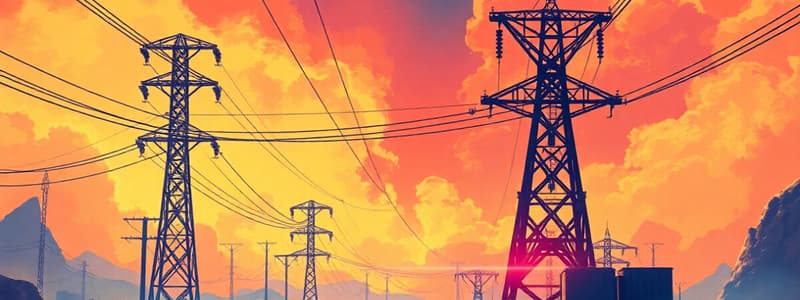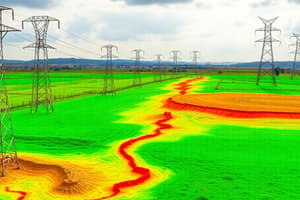Podcast
Questions and Answers
What is the primary purpose of the positive sequence network in power system analysis?
What is the primary purpose of the positive sequence network in power system analysis?
- To represent the system under symmetrical fault conditions (correct)
- To analyze unsymmetrical faults
- To determine the negative sequence impedance
- To calculate fault impedance
How does fault impedance affect fault current in an electrical power system?
How does fault impedance affect fault current in an electrical power system?
- Fault current is directly proportional to line reactance only
- Lower fault impedance results in higher fault currents (correct)
- Fault impedance does not influence fault current
- Higher fault impedance leads to higher fault currents
What is the role of zero sequence fault impedance in a fault analysis?
What is the role of zero sequence fault impedance in a fault analysis?
- It represents the impedance seen during zero sequence conditions (correct)
- It only accounts for positive sequence conditions
- It is identical to negative sequence fault impedance
- It has no impact on the fault current analysis
Which statement best describes the nature of fault impedance?
Which statement best describes the nature of fault impedance?
What happens to the power system during an unsymmetrical fault?
What happens to the power system during an unsymmetrical fault?
What does the Thevenin equivalent circuit represent in sequence networks?
What does the Thevenin equivalent circuit represent in sequence networks?
What is the significance of fault impedance loci in power system analysis?
What is the significance of fault impedance loci in power system analysis?
Why is the knowledge of fault impedance critical for protective relays?
Why is the knowledge of fault impedance critical for protective relays?
Which sequence network is primarily used for calculating the effects of current during unsymmetrical faults?
Which sequence network is primarily used for calculating the effects of current during unsymmetrical faults?
In symmetrical component analysis, what does the term 'fault current' refer to?
In symmetrical component analysis, what does the term 'fault current' refer to?
Which type of unsymmetrical fault is considered the most severe?
Which type of unsymmetrical fault is considered the most severe?
What defines the sequence impedance network?
What defines the sequence impedance network?
What is the purpose of symmetrical components in unsymmetrical fault analysis?
What is the purpose of symmetrical components in unsymmetrical fault analysis?
What equations are established for analyzing unsymmetrical faults?
What equations are established for analyzing unsymmetrical faults?
Which of the following faults is analyzed with the least severity?
Which of the following faults is analyzed with the least severity?
In unsymmetrical fault analysis, what is the role of the positive sequence network?
In unsymmetrical fault analysis, what is the role of the positive sequence network?
At which point can faults occur in an electric power system?
At which point can faults occur in an electric power system?
Which equation is described as the sequence equations in matrix form?
Which equation is described as the sequence equations in matrix form?
What is the key factor in determining fault current If during analysis?
What is the key factor in determining fault current If during analysis?
What type of fault is analyzed alongside the terminal faults of a generator?
What type of fault is analyzed alongside the terminal faults of a generator?
Which type of unsymmetrical fault is characterized by faults involving the ground and is the most severe?
Which type of unsymmetrical fault is characterized by faults involving the ground and is the most severe?
What does the sequence impedance network represent during analysis?
What does the sequence impedance network represent during analysis?
In the sequence equations, which parameter is used in the equation for the positive sequence voltage?
In the sequence equations, which parameter is used in the equation for the positive sequence voltage?
When analyzing unsymmetrical faults, what is the primary output that is determined?
When analyzing unsymmetrical faults, what is the primary output that is determined?
What are the standard types of unsymmetrical faults analyzed in order of severity?
What are the standard types of unsymmetrical faults analyzed in order of severity?
What is the role of symmetrical components in unsymmetrical fault analysis?
What is the role of symmetrical components in unsymmetrical fault analysis?
Which equation format is used to express the sequence equations in matrix form?
Which equation format is used to express the sequence equations in matrix form?
What determines the load flow studies in a power system?
What determines the load flow studies in a power system?
What type of fault is specifically analyzed at the terminals of a generator?
What type of fault is specifically analyzed at the terminals of a generator?
What conditions are analyzed to determine the sequence current during a fault?
What conditions are analyzed to determine the sequence current during a fault?
What happens to the system during an unbalanced fault condition?
What happens to the system during an unbalanced fault condition?
Which statement correctly describes negative sequence impedance?
Which statement correctly describes negative sequence impedance?
How does fault impedance impact fault analysis in power systems?
How does fault impedance impact fault analysis in power systems?
What characterizes the zero sequence network during a fault?
What characterizes the zero sequence network during a fault?
What does the voltage $V_f$ represent in the sequence network analysis?
What does the voltage $V_f$ represent in the sequence network analysis?
How do symmetrical components assist in analyzing unsymmetrical faults?
How do symmetrical components assist in analyzing unsymmetrical faults?
What is indicated by a higher fault impedance in a power system?
What is indicated by a higher fault impedance in a power system?
Why is fault impedance considered crucial for protective relay design?
Why is fault impedance considered crucial for protective relay design?
In the event of a symmetrical three-phase fault, what remains true about the power system?
In the event of a symmetrical three-phase fault, what remains true about the power system?
What do fault impedance loci represent in power system analysis?
What do fault impedance loci represent in power system analysis?
Flashcards
Unsymmetrical Fault Analysis
Unsymmetrical Fault Analysis
A method for analyzing faults in a power system where the fault is not balanced across all three phases.
L-G Fault
L-G Fault
A fault where one line is grounded.
L-L Fault
L-L Fault
A fault between two lines.
L-L-G Fault
L-L-G Fault
Signup and view all the flashcards
Sequence Equations
Sequence Equations
Signup and view all the flashcards
Symmetrical Components
Symmetrical Components
Signup and view all the flashcards
Sequence Networks
Sequence Networks
Signup and view all the flashcards
Sequence Impedance
Sequence Impedance
Signup and view all the flashcards
Fault at Generator Terminals
Fault at Generator Terminals
Signup and view all the flashcards
Fault in Power System
Fault in Power System
Signup and view all the flashcards
Sequence Networks
Sequence Networks
Signup and view all the flashcards
Positive Sequence Network
Positive Sequence Network
Signup and view all the flashcards
Negative Sequence Network
Negative Sequence Network
Signup and view all the flashcards
Zero Sequence Network
Zero Sequence Network
Signup and view all the flashcards
Unbalanced Fault
Unbalanced Fault
Signup and view all the flashcards
Symmetrical Components
Symmetrical Components
Signup and view all the flashcards
Fault Impedance
Fault Impedance
Signup and view all the flashcards
Fault Current
Fault Current
Signup and view all the flashcards
Thevenin's Equivalent Circuit
Thevenin's Equivalent Circuit
Signup and view all the flashcards
Pre-fault voltage
Pre-fault voltage
Signup and view all the flashcards
Unsymmetrical Fault
Unsymmetrical Fault
Signup and view all the flashcards
Sequence Equations
Sequence Equations
Signup and view all the flashcards
Sequence Networks
Sequence Networks
Signup and view all the flashcards
L-G Fault
L-G Fault
Signup and view all the flashcards
L-L Fault
L-L Fault
Signup and view all the flashcards
L-L-G Fault
L-L-G Fault
Signup and view all the flashcards
Symmetrical Components
Symmetrical Components
Signup and view all the flashcards
Fault at Generator Terminals
Fault at Generator Terminals
Signup and view all the flashcards
Sequence Impedance
Sequence Impedance
Signup and view all the flashcards
Fault Current
Fault Current
Signup and view all the flashcards
Sequence Networks
Sequence Networks
Signup and view all the flashcards
Positive Sequence Network
Positive Sequence Network
Signup and view all the flashcards
Negative Sequence Network
Negative Sequence Network
Signup and view all the flashcards
Zero Sequence Network
Zero Sequence Network
Signup and view all the flashcards
Fault Impedance
Fault Impedance
Signup and view all the flashcards
Fault Current
Fault Current
Signup and view all the flashcards
Thevenin's Equivalent Circuit
Thevenin's Equivalent Circuit
Signup and view all the flashcards
Pre-fault voltage
Pre-fault voltage
Signup and view all the flashcards
Analyzing Unsymmetrical Faults
Analyzing Unsymmetrical Faults
Signup and view all the flashcards
Symmetrical Components
Symmetrical Components
Signup and view all the flashcards





